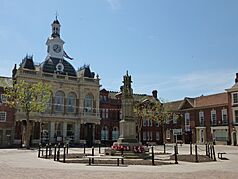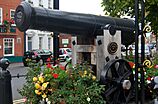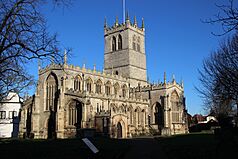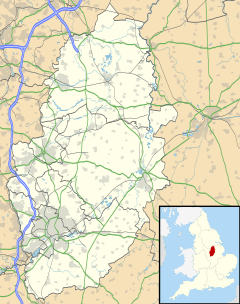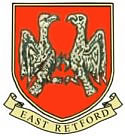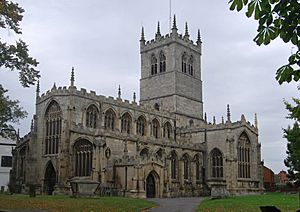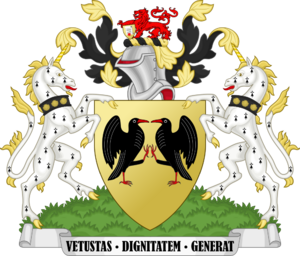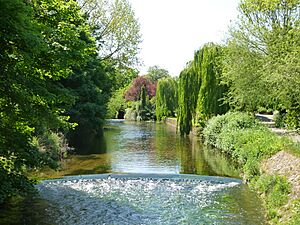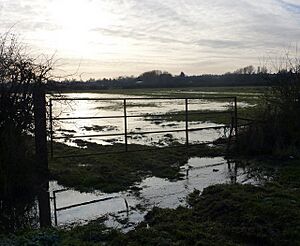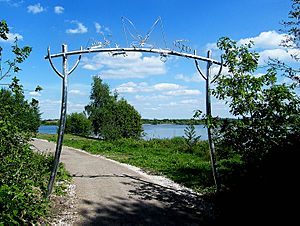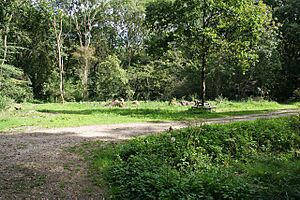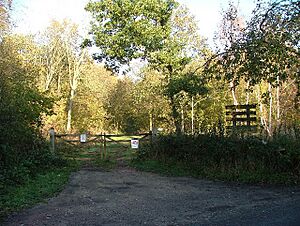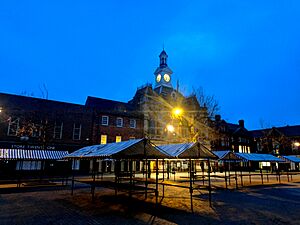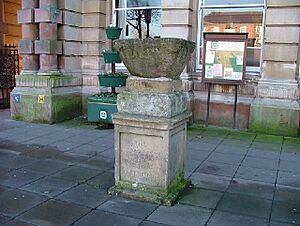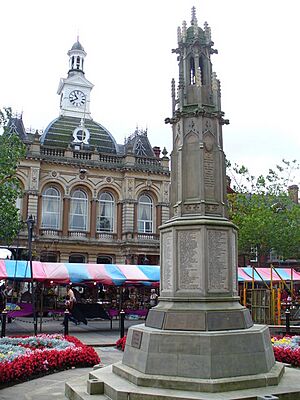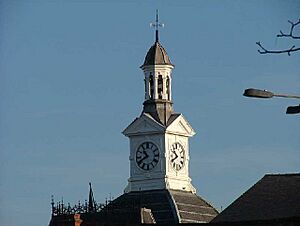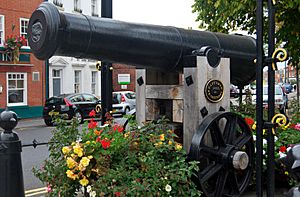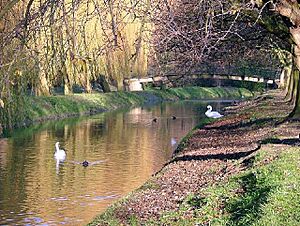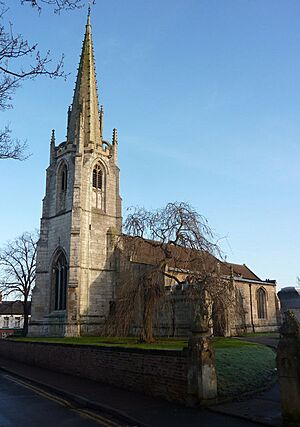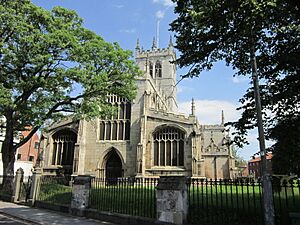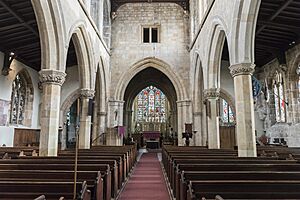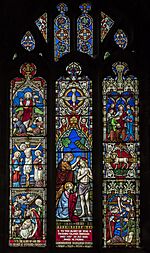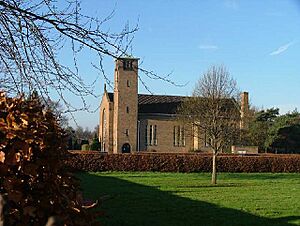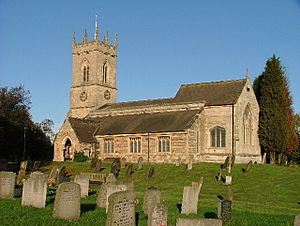Retford facts for kids
Quick facts for kids Retford/East Retford |
|
|---|---|
|
From the top: Retford Town Hall, Trinity Hospital, The Sebastopol Cannon and St Swithun's Church
|
|
| Population | 24,000 |
| OS grid reference | SK 70393 81201 |
| District |
|
| Shire county | |
| Region | |
| Country | England |
| Sovereign state | United Kingdom |
| Post town | RETFORD |
| Postcode district | DN22 |
| Dialling code | 01777 |
| Police | Nottinghamshire |
| Fire | Nottinghamshire |
| Ambulance | East Midlands |
| EU Parliament | East Midlands |
| UK Parliament |
|
Retford (pronounced 'RET-furd'), also known as East Retford, is a busy market town in Nottinghamshire, England. It sits by the River Idle and the Chesterfield Canal. Retford is about 26 miles (42 km) east of Sheffield and 31 miles (50 km) north-east of Nottingham. In 2021, about 23,740 people lived here. The main A1 road goes around the town.
The town of East Retford grew in 1878 to include areas like Ordsall and West Retford. Long ago, the local Dukes of Newcastle controlled the town's voting, making it a "rotten borough" (a place with very few voters but still a lot of power in Parliament). This changed in the 1800s. Retford was also a key place for Nonconformists, who were Protestants who didn't follow the official Church of England.
Contents
- Retford's Story: A Look Back in Time
- How Retford is Governed
- Retford's Location and Weather
- Important Buildings and Places
- Places of Worship and Faith
- Retford's Economy
- Getting Around Retford
- Fun Things to Do and Traditions
- Sports and Staying Active
- Media in Retford
- Retford Cemetery
- Learning in Retford: Schools and Education
- Town Twinning
- Famous People from Retford
Retford's Story: A Look Back in Time
Retford got its first special permission, called a charter, in 1246 from King Henry III. This allowed the town to hold a fair. Later, King Edward I let them have a Saturday market in 1275. Retford was a special town (a municipal borough) until 1974. Now, local leaders called Charter Trustees keep its old traditions alive.
The name Retford probably comes from an old river crossing point on the River Idle. It was first called Redforde. This was because the river water often looked red from the clay riverbed, especially when people and animals crossed it. The first part of the town settled was on the west side, which was less likely to flood. This area was known as West Retford.
As the town grew, it spread to the east side of the river. This eastern part became more important, which is why Retford is also called East Retford. The town's unique coat of arms shows two black birds called choughs.
A big fire destroyed most of Retford in 1528. But the town grew again after the Great North Road was rerouted through it in 1766. The Chesterfield Canal opened in 1777, and the main railway line from London to York arrived in 1849. These transport links helped Retford become a busy place. In 1961, the Great North Road was moved to go around the town, and part of the old road became a walking area.
The Pilgrim Fathers, who were early settlers of Plymouth Colony in America, came from nearby villages like Babworth and Scrooby. These villages are just outside Retford.
In 2007, some lower parts of Retford were flooded during heavy rains. Kings Park was under three feet of water, and nearby supermarkets were also affected.
How Retford is Governed
Retford has two main levels of local government. These are the Bassetlaw District Council and Nottinghamshire County Council. The town itself doesn't have a separate parish council. Instead, local councillors who represent Retford's areas act as "charter trustees." They meet a few times a year to look after the town's old traditions, like choosing a mayor each year.
Retford's Administrative Past
East Retford was a very old town with special rights. In 1835, it was noted as a "borough by prescription," meaning its exact start date as a borough was unknown. It became a municipal borough in 1836, which allowed it to appoint a mayor.
Over time, Retford grew beyond its original boundaries. In 1878, the borough was made larger to include all of Ordsall and West Retford, and parts of Clarborough. By 1921, all the smaller areas within the borough were combined into one parish called East Retford.
The official name of the borough stayed East Retford until 1974. Then, it became part of the larger Bassetlaw district. The charter trustees were set up to keep Retford's civic traditions alive.
The town's coat of arms features two choughs, which are birds. These birds came from an old town seal. The crest has a lion resting its paw on a small shield, which shows a document about the town's old Royal Charters. The unicorns on the arms come from the family crest of Lord Galway, who was an important figure in the town's history.
Voting for Parliament
From 1316, Retford was a "parliamentary borough," meaning it could send two people to represent it in Parliament. However, by 1330, the town was so poor that it asked to be excused from this duty because it couldn't afford to pay its representatives. It wasn't until 1571 that Retford was represented again.
The East Retford constituency became known as one of the most corrupt "rotten boroughs." This meant that a few powerful people, like the Duke of Newcastle, could control who was elected. There were many debates in Parliament about whether to give Retford's voting rights to bigger towns like Manchester or Birmingham. Some people even tried to make Retford seem more corrupt than it was to ensure it lost its voting rights.
In 1830, the voting area for Retford was made much larger to include the whole northern part of Nottinghamshire. This helped Retford keep its seats in Parliament. In 1885, the constituency was changed to Bassetlaw. Retford was moved to the Newark constituency in 1983 but returned to Bassetlaw in 2010.
The Bassetlaw constituency was held by the Labour party for a long time, from 1929 until 2019. The current Member of Parliament (MP) for Bassetlaw is Brendan Clarke-Smith from the Conservative party.
Retford's Location and Weather
Retford is in a flat, fertile river valley with a wide flood plain on both sides of the River Idle. This means that low-lying areas near the river can flood. The ground underneath is made of old rocks and coal. To the west, there are sandstone hills, and to the east, there are heavy clay lands.
Weather in Retford
Retford is about 18 meters (59 feet) above sea level. The weather is generally mild and warm. It has an oceanic climate, which means it has moderate temperatures and rainfall throughout the year. The average yearly temperature in Retford is about 10.1°C (50.1°F). The average rainfall is about 685 mm (27.0 inches).
Understanding Flooding in Retford
Because Retford is in the Idle River Valley, low-lying areas can flood. Flooding usually happens in the wide flood plain of the River Idle. Areas higher up or on sandstone (to the west) do not flood. To the north and east, the land is clay and used to be marshy. Dutch engineers drained this marshland in the 1600s.
"Hardmoors," an area next to the Idle at Ordsall, got its name because it floods and freezes in winter. The Environment Agency monitors the river's depth. The highest level ever recorded was 1.79 meters (5 feet 10 inches) during Storm Babet in October 2023.
Old records show many floods in Retford's history:
- A "Great Flood" in 1775 destroyed a house.
- The town flooded in February 1795.
- "Serious floods" happened in 1872.
- A "Great Flood" in 1886 caused a lot of damage.
- Floods also occurred in 1922 and 1930.
- In June 2007, parts of the town, including Kings Park and supermarkets, were flooded.
- In November 2019, there was widespread flooding along the Idle flood plain, affecting the town center and a hedgehog rescue center.
- In March 2020, 31 properties were affected by flooding after a month's worth of rain fell in one day.
- In January 2021, low-lying land near Victoria Road flooded, leading to calls for better flood protection.
- In October 2023, 200 houses were evacuated due to extensive flooding from Storm Babet.
Nature and Wildlife Around Retford
The area around Retford has diverse landscapes and wildlife. There are 30 ancient woodlands in Bassetlaw, and the town is surrounded by a rich ecosystem with rare animals and birds.
The Idle Valley Nature Reserve, managed by the Nottinghamshire Wildlife Trust, is the largest nature reserve in Nottinghamshire. It covers 450 hectares (1,112 acres) and includes old gravel quarries that have become wetlands. This reserve is the largest wetland area in Nottinghamshire and is home to over 250 bird species, making it a top bird-watching spot in the UK. You can often see amazing starling murmurations (large flocks flying together) there.
The River Idle is important for eels. An "eel pass" was installed in 2018 to help them move upstream. Nine types of bats live in and around Retford, including Daubenton's bat and common pipistrelle. You can also see many mammals and amphibians like hedgehogs, frogs, rabbits, badgers, and red foxes.
In 2021, the Nottinghamshire Wildlife Trust released eight beavers (four adults and four young) into a special enclosure at the Idle Valley Nature Reserve. This was the largest release of beavers in the UK at that time. Beavers help create new wetland habitats.
Bassetlaw has 19 special areas called Sites of Special Scientific Interest (SSSIs), covering woodlands, wetlands, and grasslands. These areas are important for their plants, insects, and birds. Some SSSIs near Retford include:
- Ashton's Meadow: A hay meadow with valuable plants.
- Barrow Hills Sandpits: Grassland and scrub important for insects and plants.
- Castle Hill Woods: Deciduous woodlands with rich plant and animal life.
- Chesterfield Canal: A part of the canal important for aquatic plants and insects.
- Clarborough Tunnel: Grassland around a railway line, important for plants.
- Clumber Park: Diverse habitats important for plants and animals.
- Eaton Wood: Deciduous woodland important for plants and insects.
- Gamston Wood: Ancient woodland important for plants and animals.
- Mattersey Hill Marsh: One of the best examples of mixed marsh in Nottinghamshire.
- Misson Carr: Rare wet woodlands and marsh, part of an old fenland system.
- River Idle Washlands: Open water, marsh, grassland, and woodland supporting many plants, insects, and birds.
- Treswell Woods: Ancient broad-leaved woodland on clay soils, important for plants and animals.
Important Buildings and Places
People have had different opinions about Retford over the years. In the 1800s, it was described as a "thriving and genteel market town." William White wrote in 1853 that its "open and spacious Market-place" gave it an "air of importance, comfort, and wealth."
In 1908, a guide noted that Retford's closeness to the "Dukeries" (large estates) made it attractive to visitors. It was also seen as a good place to live. The guide mentioned the beauty of the drive into town and its "antiquity."
However, the architectural historian Nikolaus Pevsner was not impressed in 1951, calling it a "singularly unattractive town" with few special buildings.
More recently, American author Bill Bryson praised Retford in his book Notes from a Small Island. He called it a "delightful and charming place." He loved its "exceptionally large and handsome market square" and the "weighty black cannon" from the Crimean War. He also found the shops "prosperous and well ordered."
The Market Square
The Square is the heart of Retford. It features a fancy Victorian Town Hall (a Grade II listed building) inspired by French design. In front of it is the Broad Stone, also a Grade II listed item.
The Broad Stone's Story
Legend says the Broad Stone had a hollow that was filled with vinegar during plague times to clean coins. However, it's more likely to be the upside-down base of an old boundary marker or a market cross.
Retford War Memorial
The war memorial in The Square is a Grade II* listed building. It looks like an Eleanor Cross, with an octagonal (eight-sided) shape and a Gothic design. It was revealed in 1921. The memorial has an eternal flame and lists the names of men killed in the First World War and Second World War. A plaque for the Korean War was added in 2008.
Other war memorials in town include the Sevastopol Cannon in Cannon Square, which remembers those who died in the Crimean War. St Swithun's Church has a window dedicated to the Sherwood Rangers who died in the Second Boer War. There are also oak boards in St Swithun's listing 205 fallen from the First World War.
St Saviour's Church has a memorial for 65 men killed in the First World War. All Hallows’ Church in Ordsall has a granite cross memorial. The Fives Court, a Grade II listed monument at the old King Edward VI school, was built in memory of a former pupil, Captain William Eyre, who died in the First World War.
Retford Town Hall
Retford has had several town halls over the centuries. The earliest known one was from 1388. The current Retford Town Hall was designed in the Italianate style and built in 1868. It is located south of the market place to help with traffic flow.
Cannon Square
Next to the Market Square is Cannon Square. Here you'll find St Swithun's Church and a cannon. This cannon was captured from the Russians during the Siege of Sevastopol in the Crimean War in 1856.
The cannon, its base, and the lamp arch are all listed as Grade II. The cannon arrived in Retford in 1858. It was named ‘The Earl of Aberdeen’ and officially unveiled in 1859. It was removed during the Second World War for scrap metal but was saved by Alderman Alfred Wilson. The cannon was put back in 1950.
In 2006, the Sebastopol Cannon was restored. A replica cannon was even built for a celebration to re-enact its original arrival in 1858. In 2019, a Crimea Memorial was placed in Retford Town Hall, listing 24 local men who served in the Crimean War.
King's Park: A Green Space
Kings Park opened on June 29, 1938. It celebrated the reign of King George V and the coronation of King George VI. The land for the original park was given by Mrs M Huntsman in 1937. An appeal raised money to develop the park.
In 1960, more land was donated, extending the park into the grounds of the historic West Retford Hall (built in 1699). Kings Park has won many awards, including "Britain's Best Park" in the Midlands region in 2007. It also received the Green Flag Award in 2008 and 2009. In 2014, it was voted the UK's fifth-favorite park.
The park now covers about 10 hectares (25 acres) on both sides of the River Idle, near the town center. It has formal gardens, large grassy areas for games and picnics, a children's water play area, bowling greens, tennis courts, a skate park, and rose gardens.
Historic Almshouses
- Sloswicke’s Hospital: A Grade II* listed building founded in 1657. It was built with money from Richard Sloswicke's will to provide homes for "six poore old men." The current building is from 1806.
- Trinity Hospital: A Grade II listed almshouse with gardens. It was set up over 340 years ago by John Darrell's will. The current building was designed by Edward Blore.
- Corporation Almshouses, Union Street: A row of nine almshouses built in 1823 for women of the town.
Amcott House
Amcott House is a Grade II* listed 18th-century townhouse on Grove Street. It was rebuilt around 1780 by Retford MP Wharton Amcott. Inside, it has original features like fancy plaster ceilings and an iron staircase. From the 1870s to the 1930s, it belonged to the Pegler family, who started the Northern Rubber Company. Later, it became council offices. Since 1983, it has been home to the Bassetlaw Museum.
Other Notable Buildings
Retford does not have any Grade I listed buildings (the highest protection level). However, it has six Grade II* and 123 Grade II listed buildings, which are still very important historically.
Spa Common
Retford used to have two commons: Spa Common and Far Common. Only Spa Common remains today, located behind Carolgate, next to the Chesterfield Canal. It gets its name because there was once a spa (a natural spring with special water) in its northeast corner.
Retford sits on an Artesian aquifer, where rainwater filters through sandstone. Before piped water, most houses had wells. One of these wells was on Spa Common. An old article from 1957 mentioned that the water was red and tasted like ink, probably due to iron. An early writer in 1734 described the spa water bubbling into a fancy stone basin inside a pyramid-shaped building. This building was later demolished, and today there is no trace of the spa.
Places of Worship and Faith
The area around Retford has had a huge impact on Christianity worldwide. Every English-speaking nonconformist church can trace its roots back to this region.
St Michael the Archangel, West Retford
The St Michael the Archangel church in West Retford is a Grade II* listed building made of limestone. It was dedicated in 1227. The oldest part is the south aisle and a chapel dedicated to Oswald of Northumbria. Its most striking feature is the octagonal (eight-sided) spire on a square tower, which is thought to be a copy of a spire in Rouen, France, from the 1300s.
The spire was once topped with an iron cross, but a strong storm in 1855 damaged it. The current weather vane replaced the cross. The famous architect Augustus Pugin called the spire and tower "a poem in stone." The church has six bells, with the oldest from 1619.
St Oswald's chapel is the oldest part of the church. A carved statue of St Oswald is in a niche there. The church was greatly restored in 1863. The window above the altar was designed by William Butterfield.
In the church grounds, there is a stone called the ‘preaching cross’. It might be an old boundary marker or a plague stone, similar to the Broadstone in East Retford.
St Swithun's, East Retford
St Swithun's Church, East Retford is a Grade II* listed church in East Retford, dedicated to St Swithun. It was founded in 1258 and is in the town center.
The church has a cross shape and mostly features Perpendicular Gothic architecture. A big fire in Retford in 1528 damaged the church. The tower and chancel (the area around the altar) collapsed in 1651 and were rebuilt in 1658. So, the current building is largely from restorations in 1658, 1854-5, and 1905.
The church has a square tower with battlements, a clock, and 10 bells. The north transept (a part of the church that sticks out) is the oldest, almost untouched section. It is now a chapel and war memorial. The church has a stone pulpit, an oak eagle lectern, and a large organ. The Victorian stained glass windows include works by famous artists.
The figure above the southern door is said to be St Swithun, but some believe it's a bishop. It was reportedly brought from a monastery in Portugal around 1895.
St Joseph's Catholic Church
Before the 20th century, Catholics in Retford mostly worshipped in homes. The need for a Catholic church grew with more Irish workers and Italian immigrants. In 1895, a "tin chapel" was built.
As the Catholic community grew, a larger church was needed. The current Catholic church, St Joseph's, opened in 1959. It was designed in a modern Romanesque style with Art Deco elements. The church was reordered in 1968, and a large sculpture was added. St Joseph's is a prominent landmark on Babworth Road, with its bell tower. Next to the church is St Joseph's Catholic Primary School.
All Hallows, Ordsall
Ordsall is now a suburb of Retford. Its church, All Hallows, is a Grade II* listed building. The first known rector was in 1277. The current building dates from that period but was rebuilt in the 1800s. The church has a short, square tower from the 1400s. The top of the tower was repaired in 1823 after being struck by lightning.
The church has stained glass windows by Camm Brothers and James Powell and Sons. There are also unusual brass plates from the 1600s and 1700s.
St Saviour's, Retford
St Saviour's is a Grade II listed church on Moorgate Hill. It was designed by architect Edward James Willson and finished in 1829, costing £4,000.
The church is built of yellow brick, which has turned dark grey over time. It has two octagonal towers at the west end. A plaque inside says the first stone was laid on June 2, 1828. The church was restored in 1877–8. In 2001, the inside was changed, with oak pews replaced by individual seats.
The church seemed much bigger than needed for the number of people attending. In 1851, the average morning congregation was 300 adults and 123 children.
Grove Street Methodist Church
The current Grade II listed Methodist chapel on Grove Street was built in 1880. It was designed by the same architects as Retford Town Hall. The chapel has beautiful architectural details inside and out. It also has flooring laid in the early 1900s by Italian craftsmen.
Nonconformist History
Retford and its surrounding area have many historic churches and a strong nonconformist tradition. This means many people chose not to follow the official Church of England.
Pilgrim Fathers The Pilgrim Fathers, who settled Plymouth Colony in America, came from villages like Babworth and Scrooby near Retford between 1586 and 1605. At the time, they were called 'Separatists'. Most stayed in Nottinghamshire to try and change the church from within.
The Bassetlaw Museum in Retford opened a special gallery in 2019 dedicated to telling the story of the Pilgrim Fathers. It includes a recreation of William Brewster's study.
Quakers Retford played a part in the early history of the Society of Friends, also known as Quakers. In the 1650s, James Parnell, born in Retford, converted to the Quaker faith. He became a well-known preacher and writer before he died at a young age, becoming known as 'The Boy Martyr'.
Methodism Retford was also involved in the early history of Methodism. John Wesley, a founder of Methodism, preached in the town square in 1779. Methodism was brought to Retford by John MacFarlane in 1776. When Wesley visited again at age 83, he preached in an orchard in West Retford. A tablet marks the spot where he preached.
Other Places of Worship
- The Bridge Church, Bridgegate
- The Well, Hospital Road (a Baptist church)
- St Alban's Church, London Road (a Grade II listed Edwardian church, now disused after a fire in 2008)
- Salvation Army, Exchange Street
- Hallcroft Methodist Church
- All Saints, Babworth (a Grade I listed church on the outskirts of Retford)
Retford's Economy
Today's Economy
Since the 1980s, many of Retford's older companies, like engineering and wire rope manufacturers, have closed. The town's economy now focuses more on services.
Retford is an important business center for the local area. It has large supermarkets, many independent shops, and a market on Thursdays, Fridays, and Saturdays. In 2013, only 9% of shops in Retford's town center were empty, which was much lower than the national average. Bassetlaw Council has invested in improving Retford's market square and Enterprise Centre.
Retford has a strong economy with low unemployment rates. Many people work in retail, health, manufacturing, education, and hospitality. There are also jobs in arts, recreation, finance, and insurance. While many people work locally, good transport links mean some Retford workers travel to nearby cities like Sheffield, Doncaster, and Lincoln, and even London.
The Northern Rubber Company, started in 1871, has become Icon, a company that makes special aerospace parts and employs over 200 people. Langley Holdings, based in Retford, owns many companies that make parts for cars, Airbus wings, and power systems for data centers. In 2012, Langley Holdings bought a German printing press company.
Brewing was once important in Bassetlaw. Retford was also a major hop market. This tradition has been revived by local microbreweries like Harrisons Brewery and Pheasantry Brewery.
Retford's Economy in the Past
Retford didn't have the huge industrial growth seen in other towns. It remained mostly a rural market town. Historically, it traded farm produce and also made hats, sail-cloth, rope, paper, and leather.
In 1788, Major John Cartwright built The Revolution Mill, a steam-powered wool mill, near the Chesterfield Canal. It employed about 600 people but failed a few years later.
Hezekiah Clark started a dyeing business in Retford in 1798, which became Clarks of Retford. This business later became known for dry cleaning and laundry, with many shops, before closing in the 1980s.
New paper mills and iron works were built in the mid-1800s. The Northern Rubber Company started in 1871, benefiting from its location near two important railway lines.
The land around Retford was important for growing hops from the 1600s. These "North Clay hops" were strong and used in beers. However, hop farming in the area has now stopped.
Women's Role in Retford's Economy
Women have always played a big part in Nottinghamshire's economy, especially in industries like lace making and farming. In Retford, women were active in the economy, and some businesses, like Clark's of Retford, relied heavily on female workers.
Historically, most beer in the UK was made by women, called 'brewsters'. Many old pubs in Retford were managed by women. Women also owned other businesses. For example, in 1828, the Post Office was run by Miss Elizabeth Barker. Later, Mrs Elizabeth Taylor ran it. An old postwoman, 'Old Betty Chapman,' delivered letters within living memory.
In an 1831 business directory, women were listed as grocers, boat owners, stay makers, farmers, booksellers, shoemakers, and shopkeepers. Several pubs were also run by women.
The first female councillor on Retford Town Council was Mrs Ellen Gentle Howell, elected in 1926. The first woman to become mayor of Retford in her own right was Mrs M E Williamson JP in 1951. The first female magistrate was Miss Grace M Bradshaw in 1933.
A plaque at Retford train station celebrates the work of the WVS (Women's Voluntary Service) of Retford. Between 1940 and 1946, they served over 2 million meals to soldiers in their canteen.
Getting Around Retford
Roads
Retford was historically on the Great North Road. Now, the A1 trunk road and the A57 bypass the town. These roads connect Retford to major towns and cities, with London being just over two hours away. The East Retford bypass was built in stages, mostly along the old A57.
Buses
Several bus companies serve Retford, including Stagecoach and TM Travel. You can take buses to Worksop, Newark, Nottingham, and Doncaster. Retford bus station is also the end point for the National Express coach service from London.
The current bus station opened in 2007 and cost £1.4 million. It won an award in 2008 for its design. The new station has traffic controls to prevent vehicles from driving through illegally, which happened at the old station.
Railway
Retford railway station is at a point where two railway lines meet:
- The East Coast Main Line connects London, Yorkshire, and Scotland. Trains to London Kings Cross take about 1 hour and 20 minutes.
- The Sheffield–Lincoln line provides trains to Sheffield, Lincoln, Worksop, and other towns.
Retford station was given Grade II listed status in 2020. This means it's a historically important building. The station buildings, from 1891-1892, are noted for their well-preserved design and ornate details, especially in the dining and refreshment rooms.
Canal
Retford is connected to the UK's inland waterways by the Chesterfield Canal. This canal was originally built for broad-beam boats up to Retford, but now narrower boats are more common. The canal starts at Chesterfield in Derbyshire.
The canal was built to transport coal, limestone, and lead from Derbyshire, and iron from Chesterfield. Today, it is mainly used for leisure. The Retford Mariners Boat Club (R.M.B.C) is based in Retford, near the Town Lock.
In 1978, the Chesterfield Canal made international news. A maintenance team accidentally pulled out a large wooden plug while dredging. This plug was designed to drain sections of the canal for repairs. The water drained harmlessly into the River Idle, but the incident became a national and international story.
An old crane at Retford Wharf from the early 1900s was listed as Grade II in 1996.
Air Travel
Retford (Gamston) Airport is a private airport located a few miles south of Retford in the village of Gamston. It is operated by Gamston Aviation Ltd.
Fun Things to Do and Traditions
Bassetlaw Museum
Retford is home to the Bassetlaw Museum, which opened in 1983. It has many collections donated by local people and tells the history of North Nottinghamshire. Highlights include an Anglo-Saxon boat and old photographs. In 2009, it was named Nottinghamshire Museum of the Year after major renovations. It is located in the Grade II* listed Amcott House.
The museum has over 27,000 photographs of North Nottinghamshire towns, villages, and people from the 1870s onwards. In 2019, The Pilgrims Gallery was added to celebrate the 400th anniversary of the Mayflower voyage to America.
Theatres and Cinemas
Retford has two theatres:
- The Majestic Theatre is a Grade II listed Art Deco building. It hosts famous entertainers, music concerts, and plays. It opened in 1927 as a cinema and theatre. Volunteers have restored its original features.
- Retford Little Theatre is a smaller theatre that hosts the Retford Little Theatre amateur drama group.
Retford also had other cinemas in the past, like The Picture House (later The Roxy) and The Regent Theatre (later The Ritz), which is now a Masonic hall.
Historic Pubs
Retford, being on the Great North Road, traditionally had many pubs. In 1831, there were 27 pubs and 11 beer houses. By 1896, this number grew to 56 inns. Retford's pubs have been important for its social and cultural life.
Many historic pubs are listed buildings:
- The White Hart: An 18th-century coaching inn with a cobbled yard for horses.
- The Vine Inn: An 18th-century public house.
- Whitehouse Inn: An 18th-century inn on the south edge of town.
- The Olde Sun: A 16th-century timber-framed building, one of the oldest in town.
- The Crown Inn: From 1754, once a main business place.
- The Queen's Head: A 19th-century public house.
- The Black Boy: A 19th-century public house. In 2020, its sign was removed due to concerns about its name, which is said to refer to King Charles II.
In 1831, several pubs were run by women, including Ann Green of the Black Head and Mary Barlow of the Granby.
Sundown Adventureland
Sundown Adventureland is a 30-acre children's theme park for kids under 10. It's located near Retford in Rampton. It started as a farmyard in 1968 and is still owned by the Rhodes family. The park attracts over 270,000 visitors a year. In 2019, TripAdvisor ranked it as the 23rd best theme park in Europe.
Youth Groups
Retford has many youth groups, including The Scout Association, Girlguiding UK, St. John Ambulance, and Young Farmers. There are also 1403 ATC Retford Squadron and Army Cadets. The MOB (mini operatic bunch) is a youth musical theatre group.
Charter Day Celebration
To celebrate Retford getting its Royal Charter in 1246, the town holds a Charter Day on the first Bank Holiday in May. This event celebrated its 25th anniversary in 2018 and attracts thousands of visitors. It features music, vintage cars, street performers, dance, food stalls, and a charity market. The Fire Station performs "rescues" to show their work. A popular event is the Lions' Duck Race, where plastic ducks race on the River Idle to raise money for charity.
Retford Heritage Day
Since 2007, Retford has held an annual Heritage Day organized by the Civic Society. It's part of the National Heritage Days weekend. Retford celebrates its history with many activities and entertainment. Each year has a different theme, like "Rebels and Pilgrims" in 2016.
Morris Dancing
Retford is home to the Rattlejag Morris Dancers. This group, formed in 2002, performs traditional Morris dances using rattles, sticks, brooms, and swords. They perform at festivals, fairs, and community events.
Ghosts and Local Legends
Retford has stories of ghost sightings. In 1915, someone wrote to The Retford Times about seeing a woman in Georgian dress on Sutton Lane and another figure on the North Road. Other ghost stories include The Grey Lady at Ye Olde Bell Hotel and The Unfaithful Wife at West Retford Hotel. The Masonic Hall is also said to be haunted.
Sports and Staying Active
Bowling
Retford has facilities for flat green bowling at Goosemoor Lane and in King's Park. There are also facilities at Hallcroft. Teams from Retford and nearby areas compete in The Retford and District Bowls League.
Cricket
The Retford Town Cricket and Sports Club started in 1850. It was a founding member of the Bassetlaw Cricket League in 1904. Retford has produced players who have played at county and international levels, such as Derek Randall.
Football
Retford has two main football clubs:
- Retford United F.C., formed in 1987, known as 'The Badgers'. They play at Cannon Park.
- Retford F.C., formed in 2015, known as 'The Choughs'. They play at the SL2 Rail Stadium.
Both teams have junior sides. Babworth Rovers is also a well-known junior football team near town.
Golf
Retford Golf Club is a private club founded in 1921. It has an 18-hole course with open parkland and tree-lined fairways. It's a popular place for golf groups from the East Midlands and South Yorkshire.
Rugby
East Retford Rugby Union Football Club was founded in 1952. They play in the Midlands League Division. The club has two senior teams and a growing junior section for boys and girls.
Snooker
Retford has a long-running snooker league with two divisions.
Swimming
Retford Swimming Club represents the town in swimming competitions. The club, started in 1896, trains swimmers and competes against other teams in Nottinghamshire. They host an annual Open Meet at Ponds Forge International Pool in Sheffield.
Media in Retford
Most of Retford gets its TV signals from the Emley Moor transmitting station, which broadcasts local news from BBC Look North and Calendar News. Some residents get signals from Belmont (Lincolnshire) or Waltham (East Midlands).
For radio, Retford's official BBC Local Radio station is BBC Radio Sheffield. However, local news is also covered by BBC Radio Nottingham.
Retford has one local newspaper, the Retford Times, published on Thursdays. It was founded in 1869 and has changed its name several times over the years. It is now published by Lincolnshire Media, but its editorial offices are in Retford. The Worksop Guardian also covers stories in Retford.
Retford Cemetery
Retford cemetery is a Victorian-era cemetery that opened in 1854. It covers about 25 acres (10 hectares) and is located between Babworth Road and North Road. The Chesterfield Canal runs through the middle of the cemetery, dividing it into two halves connected by a bridge.
The cemetery originally had two chapels, one for the Church of England and one for Nonconformists, but these were taken down in the 1970s. It also had a cemetery lodge, which is now a private home. The cemetery was extended in the 1890s and again in the 1950s.
Retford cemetery contains 14 Commonwealth war graves from the First World War and 16 from the Second World War. There is also one Polish soldier buried there.
Learning in Retford: Schools and Education
Primary Schools
- St Swithun's CE Primary Academy
- St Josephs Catholic Primary School
- Bracken Lane Academy
- Thrumpton Primary Academy
- Carr Hill Primary School
- Ordsall Primary School
Senior Schools
- The Elizabethan Academy
- Retford Oaks Academy
- St. Giles
As part of a big change to secondary schools in the Bassetlaw area, all schools have moved to new buildings. Retford also has a Post-16 centre, which offers vocational and technical courses, and higher education.
Historic Schools
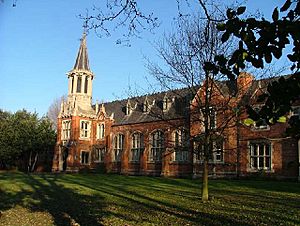
King Edward VI Grammar School opened in 1857. It was designed by the famous architect Decimus Burton. The school's history goes back to 1519. It took in boarding students until 1938. During the Second World War, over 6,000 evacuee children came to Retford, and some boys from Great Yarmouth Grammar School were taught at King Edward VI Grammar School. The school eventually became part of the Retford Oaks Academy and moved to new buildings, but the original Grade II listed buildings still stand on London Road.
The school donated money for a sledge used by Robert Falcon Scott on his expedition to the South Pole. Scott thanked the boys and named a sledge ‘Retford’.
Retford County High School for Girls started from a meeting in 1891 to create a higher education school for girls. It educated about 400 girls from the 1950s to 1970s. In 1979, the secondary schools in Retford were reorganized, and boys were admitted for the first time. The school became 'The Elizabethan High School' and later The Elizabethan Academy. The old Pelham Road site is now a housing estate.
Town Twinning
Retford has "twin town" connections with:
- Pfungstadt (Germany)
- Aurillac (France) since 1980
- Farmers Branch (United States) since 1980
Famous People from Retford
- Hugh Armstrong (actor) (actor)
- Anthony Perrinott Lysberg Barber (politician)
- Max Blagg (poet)
- Stephen Booth (crime writer)
- Frank Branston (journalist, mayor of Bedford)
- Ed Bulling (footballer)
- John Cartwright (built The Revolution Mill)
- Thomas Clater (painter)
- Doc Cox (attended King Edward VI School)
- Robert Craufurd (Major General, MP for East Retford)
- Anne Denman (ancestor of Queens Mary II and Anne)
- John Glasby (novelist, chemist, mathematician)
- Catherine Grace Frances Gore (Moody) (novelist, playwright)
- Mike Hall (cricketer)
- Kat Hawkins (presenter, producer)
- George F. Hopkinson (World War II commander)
- Philip Jackson (actor)
- John Kelsall (composer, conductor, lecturer)
- Liam Lawrence (football player)
- Ted Linley (footballer)
- Arthur James Mason (clergyman, scholar)
- Jim McCairns (pilot)
- Dorothy May Meads (author, college principal)
- Samuel Milner (physicist)
- Andrew Moody (journalist)
- Francis Orpen Morris (ornithologist, entomologist)
- James Parnell (prominent Quaker, "The Boy Martyr")
- Albert Peatfield (cricketer)
- Derek Randall (cricketer)
- John Taylor (publisher)
- Francis Thornhagh (Parliamentarian soldier, MP for East Retford)
- Sam Trickett (poker player)
- Russell Wainscoat (footballer)
- John Warham (photographer)
- Thomas White (politician, MP for Retford)
- Samuel Wright (nonconformist)
|


